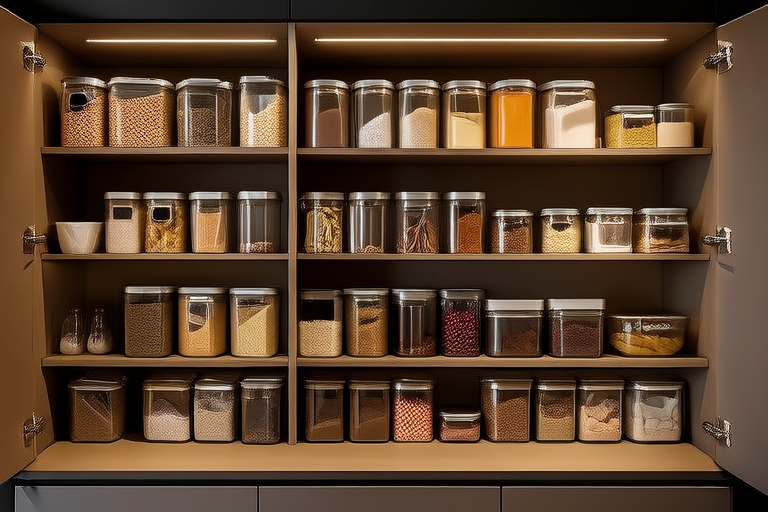Essential Tools and Equipment for Efficient Home Food Storage Solutions
Introduction
Efficient home food storage is not just about keeping your groceries fresh; it’s also about saving money, reducing waste, and ensuring the safety of your family. Proper storage solutions can extend the shelf life of perishable items, prevent contamination, and maintain the nutritional value of your food. In this article, we will explore essential tools and equipment that can help you create an efficient home food storage system. Whether you’re a beginner or an experienced cook, these tips will help you optimize your pantry and fridge.
Understanding the Basics: Types of Storage Containers
Before diving into specific tools, it’s important to understand the different types of storage containers available. Each type has its own advantages and is suited for particular kinds of food. Here are some common options:
Glass Jars
Glass jars are a popular choice for food storage due to their durability and reusability. They are ideal for storing dry goods like grains, pasta, and spices. Glass jars are also great for preserving homemade jams, pickles, and sauces. One of the key benefits of glass jars is that they don’t retain odors, making them perfect for storing sensitive foods like nuts and herbs.
Plastic Containers
Plastic containers come in various sizes and shapes, making them versatile for different storage needs. They are lightweight and easy to stack, which is convenient for organizing your pantry. However, it’s important to choose BPA-free plastic containers to avoid harmful chemicals leaching into your food. Plastic containers are excellent for storing leftovers, soups, and salads.
Silicone Bags
Silicone bags are a newer option that has gained popularity due to their flexibility and eco-friendliness. Unlike traditional plastic bags, silicone bags are reusable and can be sealed with airtight closures. They are perfect for storing liquids, snacks, and even freezing fruits and vegetables. The flexible nature of silicone makes it easier to squeeze out air, which helps preserve freshness.
Vacuum Sealing Systems
For those looking to extend the shelf life of their food, vacuum sealing systems are a game-changer. These devices remove air from the packaging, preventing oxidation and bacterial growth. Vacuum-sealed food stays fresher longer, especially when combined with proper freezing techniques. This method is particularly useful for bulk purchases and large cuts of meat.
Choosing the Right Tools: Beyond Containers
While storage containers are crucial, there are other tools that can enhance your food storage experience:
Labels and Markers
Organizing your pantry is easier when everything is clearly labeled. Invest in reusable labels or use permanent markers to write expiration dates directly on containers. This practice ensures that you always know what’s inside each container and when it was stored. It also helps prevent over-purchasing of similar items.
Temperature-Controlled Fridges and Freezers
Maintaining the right temperature is vital for preserving food. Ensure your fridge is set between 34°F and 40°F (1°C and 4°C) and your freezer at 0°F (-18°C) or lower. Regularly cleaning the fridge and freezer coils can improve efficiency and save energy. Consider using a temperature gauge to monitor the exact temperature, especially if you have a lot of frozen items.
Humidity Control Devices
Moisture can lead to mold growth and spoilage. For items like fruits and vegetables, consider using humidity control devices such as moisture absorbers or dehumidifiers. These tools help maintain optimal humidity levels, ensuring that your produce stays fresh longer.
Practical Tips for Effective Food Storage
Implementing the right tools is only half the battle. Here are some practical tips to maximize the efficiency of your food storage solutions:
Organize Your Pantry
Start by decluttering your pantry and removing expired items. Group similar items together, such as canned goods, baking supplies, and condiments. Use shelf dividers to keep items organized and easily accessible. Label shelves with categories to make finding items quicker.
Rotate Stock
To ensure that you use older items first, implement a first-in, first-out (FIFO) system. Place new items behind older ones on the shelf. This practice minimizes waste and ensures that nothing goes to waste. You can also use color-coded stickers to mark the purchase date of each item.
Freeze Properly
When freezing food, wrap items tightly in aluminum foil or plastic wrap before placing them in freezer bags. This prevents freezer burn and maintains the quality of the food. Label each package with the contents and the date it was frozen. Frozen food can last several months, but it’s best to consume it within three to six months for peak quality.
Real-Life Case Study: Optimizing a Small Kitchen
Let’s take a look at how one family optimized their small kitchen for efficient food storage. The Smiths had limited space in their pantry and fridge, leading to frequent food waste. By implementing the following strategies, they significantly reduced waste and saved money:
- Invested in stackable plastic containers: This allowed them to maximize vertical space in their fridge.
- Used vacuum sealing for bulk purchases: They purchased meat in bulk and used a vacuum sealer to freeze it in smaller portions.
- Implemented FIFO labeling: They marked all items with color-coded stickers and ensured older items were used first.
- Optimized freezer usage: They cleaned the freezer coils regularly and used temperature gauges to monitor the temperature.
As a result, the Smiths saw a noticeable decrease in food waste and enjoyed fresher meals throughout the week.
Conclusion
Creating an efficient home food storage system requires more than just buying the right containers. By understanding the different types of storage solutions available and incorporating additional tools like labels, temperature controls, and humidity management, you can extend the shelf life of your food and reduce waste. Remember to organize your pantry, rotate stock, and freeze properly to maximize efficiency. Start by implementing small changes and gradually build a comprehensive storage system tailored to your needs. With these tips, you’ll be well on your way to enjoying fresher, healthier meals while saving both time and money.
